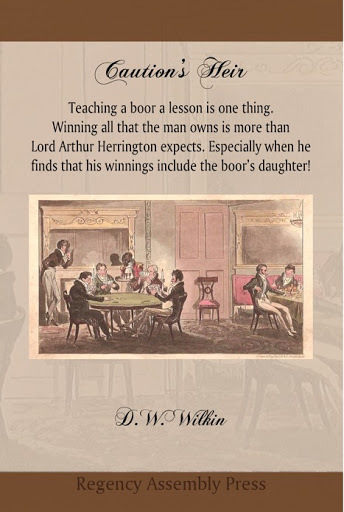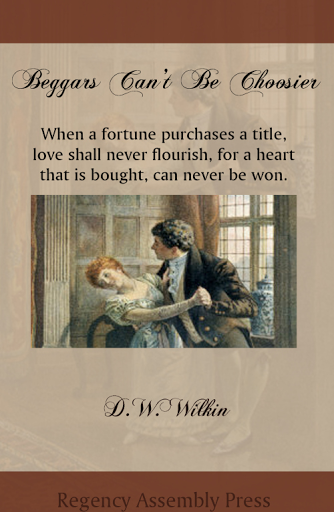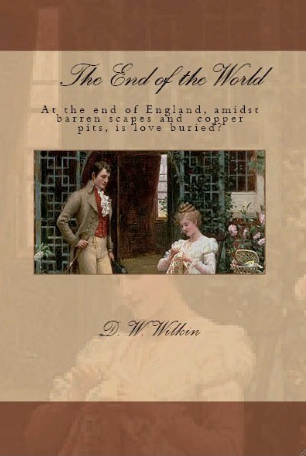D.W. Wilkin's Blog, page 36
August 4, 2016
Regency Personalities Series-Mary Wells (Actress)
Regency Personalities Series
In my attempts to provide us with the details of the Regency, today I continue with one of the many period notables.
Mary Wells (Actress)
16 December 1762 – 23 January 1829
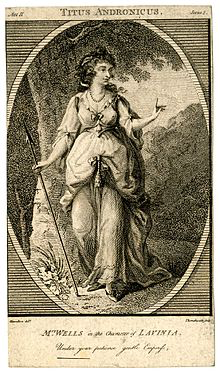
Mary Wells
Mary Wells was the daughter of Thomas Davies, a carver and gilder in Birmingham, and was born there on 16 December 1762. Her father died in a madhouse while she was a small child. Her mother kept a tavern frequented by actors, and among others by Richard Yates, under whose management Mary appeared at the Birmingham Theatre as the young Duke of York in Richard III, playing subsequently Cupid in William Whitehead’s Trip to Scotland, and Arthur in King John. After visiting Bath and York she went to Gloucester, where she played Juliet to the Romeo of an actor named Wells, to whom she was married in St. Chad’s Church, Shrewsbury. Wells shortly afterwards deserted her.
On 1 June 1781, as Madge in Isaac Bickerstaffe’s Love in a Village and Mrs. Cadwallader in Samuel Foote’s Author, she made her first appearance at the Haymarket. John Genest says that she was excellent in both characters. Jenny in Lionel and Clarissa (Bickerstaffe) followed, and on 3 September in John O’Keeffe’s Agreeable Surprise she was the first Cowslip, a name that stuck to her (though she is occasionally spoken of as ‘Becky’ Wells). Genest wrote that nothing could be superior to her acting as Cowslip and that of John Edwin as Lingo.
On 25 September, as Nancy in Love in a Camp, she made her first appearance at Drury Lane, where also she played on 29 October. Jenny in the Gentle Shepherd, adapted from Allan Ramsay by Richard Tickell. Harriet in the Jealous Wife, Widow O’Grady in the Irish Widow, Flora in She Would and She Would Not (Colley Cibber), and Jacintha in the Suspicious Husband followed. At the Haymarket in 1782 her name appears to Molly in the English Merchant and Bridget in the Chapter of Accidents (Sophia Lee). She also, as she says, replaced Mrs. Cargill, who had eloped, as Macheath in the Beggar’s Opera, with the male characters played by women and vice versa. She made a distinguished success, and was received with great enthusiasm. She played at Drury Lane Kitty Pry in The Lying Valet, and Jane Shore on 30 April 1783, her first appearance in tragedy. At the Haymarket she was on 6 July 1784 the original Fanny in Elizabeth Inchbald’s Mogul’s Tale, on 6 September the first Maud in O’Keeffe’s Peeping Tom, the eponymous Isabella, and Lady Randolph in Douglas.
Nancy Buttercup, an original part in O’Keeffe’s Beggar on Horseback, was seen at the Haymarket on 16 June 1785. On 14 December she made her first appearance at Covent Garden as Jane Shore (in her own opinion, her best performance), playing also Laura in Edward Topham’s farce The Fool, which her acting commended to the public. After repeating Lady Randolph and Isabella, she was on 5 January 1786 Imogen in Cymbeline; William Woodfall in the Morning Chronicle awarded her praise for the performance. Andromache in the Distressed Mother (Ambrose Philips) followed, and was succeeded by Shakespearean heroines (Rosalind, Portia), and Fidelia in the Plain Dealer; and she was on 24 April the first Eugenia in The Bird in a Cage, or Money works Wonders, altered from James Shirley. At the Haymarket in 1786 she played some unimportant original parts. When John Palmer made in 1787 his trial effort at the Royalty Theatre, Wellclose Square, she gave her imitations of Mrs. Siddons and other actresses, and was paid £50 a night.
She came back to Covent Garden, where she was on 17 September 1787 Mrs. Page in the Merry Wives of Windsor and played Lady Percy, Lady in Comus, Rosina, Anne Lovely, and Fatima in Cymon. Here she remained some time, acting in the summer at Cheltenham, Brighton, and Weymouth, where she was favoured by royalty.
Her domestic affairs became complicated. She had entered into close relations with Edward Topham, a captain in the Guards, who was concerned in a daily newspaper called the World, in the production of which she assisted. She had also backed bills for a considerable amount for her brother-in-law, the husband of a Miss Davies (who appeared at the Haymarket on 28 July 1786 as Amelia in the English Merchant). This guarantee involved her in endless trouble. More than once she was a prisoner in the Fleet Prison and in other places.
In the Fleet she met Joseph Sumbel, her second husband, who was confined there for contempt of court. Sumbel was a Sephardic Jew, secretary to the ambassador from Morocco, and the wedding was performed in the Fleet. A year later he sought unsuccessfully to have the marriage annulled or dissolved, declaring that she was not his wife; she meanwhile had embraced Judaism and taken the name of Leah. She subsequently became a Catholic or Methodist.
She does not seem to have acted much later than 1790, though she gave her imitations at private houses; and once attempted to give them publicly during Lent, but was prevented by the bishop of London.
She spent her later years in lodgings with her aged mother. She also applied to the Covent Garden Theatrical Fund, and received an annuity of £55 until her death in London on 23 January 1829. She was buried in St Pancras, London.
She published in 1811 ‘Memoirs of the Life of Mrs. Sumbel, late Wells, of the Theatres Royal Drury Lane, Covent Garden, and Haymarket, written by herself,’ (London, 3 vols.) The three volumes of this rambling autobiography are occupied principally with details of travels in search of her children, who refused to know her, or of friends. The remainder stock seems to have received a new title-page in 1828, when it appeared as ‘Anecdotes and Correspondence of Celebrated Actors and Actresses, including Mr. Reynolds, Mr. Kelly, Mr. Kemble, Mr. Colman, Mrs. Siddons, &c. Also an Account of the Awful Death of Lord Lyttelton.’
Her portrait, in the character of Cowslip in the ‘Agreeable Surprise,’ was engraved by John Downman (Bromley, p. 447). A portrait of her by Dewilde, as Anne Lovely in ‘A Bold Stroke for a Wife,’ is in the Mathews collection in the Garrick Club. An engraving by J. R. Smith from his own picture of her as Cowslip was published by Ackerman in 1802.


Caution’s Heir from Regency Assembly Press-Now available everywhere!
Caution’s Heir is now available at all our internet retailers and also in physical form as well
The Trade Paperback version is now available for purchase here @ $15.99 (but as of this writing, it looks like Amazon has still discounted it 10%)
Caution’s Heir is also available digitally for $4.99 @ the iBookstore, Amazon, Barnes and Noble, Kobo and Smashwords.
The image for the cover is a Cruikshank, A Game of Whist; Tom & Jerry among the ‘Swell Broad Coves.’ Tom and Jerry was a very popular series of stories at the time.
Teaching a boor a lesson is one thing.
Winning all that the man owns is more than Lord Arthur Herrington expects. Especially when he finds that his winnings include the boor’s daughter!
The Duke of Northampshire spent fortunes in his youth. The reality of which his son, Arthur the Earl of Daventry, learns all too well when sent off to school with nothing in his pocket. Learning to fill that pocket leads him on a road to frugality and his becoming a sober man of Town. A sober but very much respected member of the Ton.
Lady Louisa Booth did not have much hope for her father, known in the country for his profligate ways. Yet when the man inherited her gallant uncle’s title and wealth, she hoped he would reform. Alas, that was not to be the case.
When she learned everything was lost, including her beloved home, she made it her purpose to ensure that Lord Arthur was not indifferent to her plight. An unmarried young woman cast adrift in society without a protector. A role that Arthur never thought to be cast as. A role he had little idea if he could rise to such occasion. Yet would Louisa find Arthur to be that one true benefactor? Would Arthur make this obligation something more? Would a game of chance lead to love?
Today, the iBookstore is added, HERE
Get for your Kindle, Here
In Trade Paperback, Here
Digitally from Smashwords, Here
For your Sony Kobo, Here
Or for your Nook, Here
From our tale:
Chapter One
St. Oswald’s church was bleak, yet beautiful all in one breath. 13th century arches that soared a tad more than twenty feet above the nave provided a sense of grandeur, permanence and gravitas. These prevailed within, while the turret-topped tower without, once visible for miles around now vied with mature trees to gain the eye of passers-by.
On sunny days stain-glass windows, paid for by a Plantagenet Baron who lived four hundred years before and now only remembered because of this gift, cast charming rainbow beams across the inner sanctum. And on grey overcast days ghostly shadows danced along the aisle.
As per the custom of parish churches the first three pews were set-aside for the gentry. On this day the second pew, behind the seat reserved for the Marquess of Hroek, who hadn’t attended since the passing of his son and heir, was Louisa Booth his niece and her companion Mrs Bottomworth.
Mrs Bottomworth was a stocky matron on the good side of fifty. Barely on the good side of fifty. But one would not say that was an unfortunate thing for she wore her years well and kept her charge free of trouble. Mrs Bottomworth’s charge was an only child, who would still have been in the schoolroom excepting the fact of the death of her mother some years earlier. This had aged the girl quickly, and made her hostess to her father’s household. The Honourable Hector Booth, third son of the previous Marquess, maintained a modest house on his income of 300 pounds. That was quite a nice sum for just the man and one daughter, with but five servants. They lived in a small, two floor house with four rooms. It should be noted that this of course left two bedchambers that were not inhabited by family members. As the Honourable Mr Booth saved his excess pounds for certain small vices that confined themselves with drink and the occasional wager on a horse, these two rooms were seldom opened.
Mrs Bottomworth had thought to make use of one of the empty rooms when she took up her position, but the Honourable Hector Booth advised and instructed her to share his daughter’s room. For the last four years this is what she had done. When two such as these shared a room, it was natural that they would either become best of friends, or resent each other entirely. Happily the former occurred as Louisa was in need of a confidant to fill the void left in her mother’s absence, and Mrs Bottomworth had a similar void as her two daughters had grown and gone on to make their own lives.
The Honourable Mr Booth took little effort in concerning himself with such matters as he was ever about his brother’s house, or ensconced in a comfortable seat at either the local tavern or the Inn. If those locations had felt he was too warm for them, he would make a circuit of what friends and acquaintances he had in the county. The Honourable Mr Booth would spend an hour or two with a neighbour discussing dogs or hunters, neither of which he could afford to keep, though he did borrow a fine mount of his brother to ride to the hunt. The Marquess took little notice, having reduced his view of the world by degrees when first his beloved younger brother who was of an age between the surviving Honourable Mr Booth had perished shortly after the Marquess’ marriage. Their brother had fallen in the tropics of a fever. Then the Marquess had lost his second child, a little girl in her infancy, his wife but a few years after, and most recently his son and heir to the wars with Napoleon.
This caused the Honourable Mr Booth to be heir to Hroek, a situation that had occurred after he had lost his own wife. With that tragedy, Mr Booth had found more time to make friends with all sorts of new bottles, though not to a degree that it was considered remarkable beyond a polite word. Mr Booth was not a drunkard. He was confronting his grief with a sociability that was acceptable in the county.
Louisa, however, was cast further adrift. No father to turn to. No uncle who had been the patriarch of the family her entire life. And certainly now no feminine examples to follow but her companion and governess, Mrs Bottomworth. That Mrs Bottomworth was an excellent choice for the task was more due to acts of the Marquess, still able to think clearly at the time she was employed, than to the Honourable Mr Booth. Mr Booth was amenable to any suggestion of his elder brother for that man controlled his purse, and as Mr Booth was consumed with grief, while the Marquess had adapted to various causes of grief prior to the final straw of his heir’s death, the Marquess of Hroek clearly saw a solution to what was a problem.
Now in her pew, where once as a young girl she had been surrounded by her cousins, parents, uncles and aunt, she sat alone except for her best of friends. Louisa was full of life in her pew, her cheeks a shade of pink that contrasted with auburn hair, which glistened as sunlight that flowed though the coloured panes of glass touched it from beneath her bonnet. Blue eyes shown over a small straight nose, her teeth were straight, though two incisors were ever so slightly bigger than one would attribute to a gallery beauty painted by Sir Thomas Lawrence.
She was four inches taller than five feet, so rather tall for a young woman, but her genes bred true, and many a girl of the aristocracy was slightly taller than those women who were of humbler origins. Her back was straight and for an observant man, of which there were some few in the county, her figure might be discussed. The wrath though of her uncle the Marquess would not wish to be bourne should it be found out that her form had become a topic amongst the young men. Noteworthy though was that she had a figure that men thought inspiring enough to tempt that wrath, and think on it. A full bosom was high on her chest, below her heart shaped face. She was lean of form, though her hips flared just enough that one could see definition in her torso. Certainly a beauty Sir Thomas’ brushes would wish the honour to meet.
The vicar Mr Spotslet had at one time in his early days in the community, discussed the Sunday sermons with the Marquess. Mr Spotslet had enjoyed long discussions of theology, philosophy, natural history and the holy writ that were then thoughtfully couched in terms to be made accessible by the parish. The lassitude that had overtaken the Marquess had caused those interviews to become shortened and infrequent and as such the sermons suffered, as many were wont to note. There had been dialogues that Mr Spotslet had engaged in with the attendees of his masses. Now he seemed to have lost his way and delivered soliloquies.
This day Mr Spotslet indulged in a speech that talked to the vices of gambling. The local sports, of which the Honourable Mr Booth was an intimate, had raced their best through the village green the previous Wednesday for but a prize of one quid, and this small bet had caused pandemonium when Mrs McCaster had fallen in the street with her washing spread everywhere and trampled by the horses. Not much further along the path, Mr Smith the grocer’s delivery for the vicar himself was dropped by the boy and turned into detritus as that too was stampeded over. A natural choice for a sermon, yet only two of the culprits were in attendance this day. The rest had managed to find reasons to avoid the Mass.
Louisa squirmed a little in her seat the moment she realised that her father had been one of the men that the sermon was speaking of. Was she not the centre of everyone’s gaze at such a time? Her father having refused to attend for some years, and her uncle unable due to his illness. She was the representative of the much reduced family. Not only was it expected that the parish would look to her as the Booth of Hroek, but with her father’s actions called to the attentions of all, it was natural that they look at her again. This time in a light that did not reflect well on her father and she knew that she had no control over that at all.
Mrs Bottomworth, who might have been lightly resting her eyes, Louisa would credit her in such a generous way, came to tensing at the mention of the incident. Louisa did not want to bring her friend to full wakefulness, but Mrs Bottomworth realised what was occurring and the direction that the sermon was taking. Louisa’s companion took her hand and patted it reassuringly.
“Perhaps a social call on Lady Walker?” Mrs Bottomworth suggested as they walked back to the house after services. The house which sat just within the estate boundaries was four hundred feet off the main bridal way that led to Hroek Castle. A small road had been cleared from the gatehouse to the house that Mr Booth now maintained, and this the two women travelled.
Louisa generally appreciated visits such as this as she had gotten older, and certainly several of the adults in the neighbourhood showed a kindly interest in her education and the development of her social manners. “I think I shall go to the castle and read to my uncle.” A task that she had done each day of the last fortnight but one.
“We have not talked, but you and the Marquess had an interview with the doctors.” Mrs Bottomworth had tried to comfort her charge after that, but Louisa had waved her hand and gone to sit quietly under a yew tree that had a grand vista of the park leading to Hroek Castle.
“Uncle will be most lucky if he should be with us come Michaelmas.”
“That will be a sad day when we lose such a friend.” These were words of comfort. Mrs Bottomworth had been well encouraged in her charge by the Marquess but one could not say that they interacted greatly with one another. The Marquess ensured that his brother heeded the suggestions and advisements of Mrs Bottomworth as the Honourable Mr Booth left to his own devices would have kept his daughter in the nursery and would have forgotten to send a governess to provide her with instruction.
“Indeed, my uncle may not have been one of the great men of England, but he is well regarded in the county.” Often with that statement followed the next, “Warmly remembered is it when the Prince Regent came and stayed for a fortnight of sport and entertainment.” This had been many years before, and certainly before any of the tragedies beset the line of the Booths.
“Yes, I have heard it said with great earnestness. But come let us change your clothes and then we shall go up to the great house. I shall have Mallow fetch the gig so we may proceed all the more expeditiously.”
“That would be good, but we will have to use the dogcart. Father was to take the gig to see Sir Mark today, or so he said at breakfast.” Where Louisa knew he would drink the Baronet’s sherry for a couple hours before thinking to return, unless he was asked to stay for dinner.


August 3, 2016
Regency Personalities Series-Sir Thomas Boulden Thompson 1st Baronet
Regency Personalities Series
In my attempts to provide us with the details of the Regency, today I continue with one of the many period notables.
Sir Thomas Boulden Thompson 1st Baronet
28 February 1766 – 3 March 1828
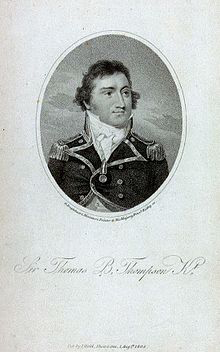
Thomas Boulden Thompson
Sir Thomas Boulden Thompson 1st Baronet was born in Barham, Kent on 28 February 1766. His uncle, through his mother, was Commodore Edward Thompson, and it was through this relative’s influence that Thomas joined the navy in June 1778, when Edward was appointed to command the sloop HMS Hyaena. He served on the Hyaena with his uncle, spending most of the time in the waters off the British Isles, before accompanying Rodney’s fleet to the Relief of Gibraltar in January 1780. The Hyaena was later entrusted with carrying copies of Rodney’s despatches.
Thompson later moved to the West Indies, being promoted to lieutenant on 14 January 1782. He was given command of a small schooner, with which he captured a larger French privateer. After the end of the American Revolutionary War, Thompson was moved onto his uncle’s flagship, the 50-gun HMS Grampus. He served off the coast of Africa until his uncle’s death in 1786, after which he was given command of the sloop HMS Nautilus. He remained in command for the next twelve months, before returning to Britain where she was paid off. He was promoted to post-captain on 22 November 1790.
He spent a number of years on land without command of a ship until the outbreak of the French Revolutionary Wars provided employment. By late 1796 he had secured command of the fourth rate HMS Leander. He then joined the Mediterranean Fleet under John Jervis, and was assigned to the squadron under Horatio Nelson. Thompson took part in Nelson’s attack on Santa Cruz in July 1797. Thompson was among those leading the landing parties, under the overall direction of Nelson and Thomas Troubridge. The initial attempts to force a landing were hampered by the wind, and when the parties made a successful landing in the evening of 22 July, they came under heavy fire from the Spanish defenders. Thompson’s party were able to advance and spike several of the enemy’s cannon, but the British forces had become dispersed throughout the town, and were forced to negotiate a truce to allow them to withdraw. Thompson himself was wounded in the battle.
Thompson was later given command of a squadron, and carried out cruises in the Mediterranean, intercepting French and Spanish ships. He returned to Gibraltar, but was ordered to sea again in June 1798 to reinforce Nelson’s squadron in their hunt for the French fleet that had earlier escaped from Toulon. He was with Nelson when they located the French fleet, under the command of Vice-Admiral Brueys, moored in Aboukir Bay. In the ensuing engagement Thompson came to the assistance of HMS Culloden, which had run aground on shoals in the entrance to the bay. Finding that there was nothing he could do, Thompson took Leander into the battle, despite his ship being considerably smaller than the French ships of the line. He anchored between the Franklin and Brueys’ flagship the Orient, firing on them in company with HMS Defence and HMS Swiftsure until the Franklin surrendered. Thompson then took the Leander to assist the British attack on the French rear.
After the battle Thompson was joined aboard the Leander by Captain Edward Berry, and sent with Nelson’s despatches to Gibraltar. Whilst sailing there, they were spotted on 18 August by the Généreux, which had escaped the Battle of the Nile. The French pursued the Leander. Being a 60 gun ship to the Généreux′s 78, and still having battle damage and men wounded from the Nile, Thompson attempted to escape, but was eventually forced to come to battle. The two eventually clashed in a long running engagement, which eventually resulted in Leander being disabled and unmanageable. After conferring with Berry, Thompson agreed to surrender. The Généreux had suffered 100 killed and 188 wounded, to the Leander′s 35 killed and 57 wounded. Arriving on board the French ship, Berry and Thompson were almost immediately stripped of their possessions. The French went on to plunder their prize, even going so far as to steal the surgeon’s equipment as he tried to attend to the wounded. When Thompson protested, and reminded the French captain of how French prisoners were treated under Nelson, he received the reply ‘I am sorry for it; but the fact is, that the French are expert at plunder.’
Thompson was later repatriated and brought to court-martial aboard HMS Alexander at Sheerness. He was honourably acquitted for the loss of his ship, the court deciding:
that his gallant and almost unprecedented defence of the Leander, against so superior a force as that of le Généreux, was deserving of every praise his country and the assembled court could give; and that his conduct, with that of the officers and men under his command, reflected not only the highest honour on himself and them, but on their country at large.
Berry was also commended, and whilst being rowed back to shore after his acquittal, Thompson was given three cheers by the crews of the ships moored at Sheerness. He was subsequently knighted and awarded a pension of £200 per annum.
Thompson was appointed to command HMS Bellona in spring 1799, joining the fleet under Lord Bridport, off Brest. He then went to the Mediterranean, sailing with the flying squadron. He was involved in the capture of three frigates and two brigs. He returned to England in autumn, and participated in the blockade of Brest, until being assigned to Sir Hyde Parker’s Baltic expedition in early 1801. He was present at the Battle of Copenhagen, but ran aground on shoals whilst trying to enter the bay. He continued to fire on the enemy’s shore batteries, but being a stationary target was heavily damaged, having 11 killed and 63 wounded. Thompson was amongst the wounded, losing a leg. He shared in the thanks of Parliament after the battle and had his pension increased to £500. He was then appointed to command the yacht HMS Mary.
Thompson was appointed Comptroller of the Navy in November 1806, an office he held until November 1816. He was created a baronet on 11 December 1806. On relinquishing the post of Comptroller he became Treasurer of the Royal Hospital at Greenwich, succeeding the late Sir John Colpoys, and also became Director of the Chest. He became Member of Parliament for Rochester in 1807, relinquishing the position in June 1818. He became a Rear-Admiral on 25 October 1809 and a Vice-Admiral on 4 June 1814. He was appointed a Knight Commander of the Order of the Bath in the reorganisation of that order on 2 January 1815, and a Knight Grand Cross of the Order of the Bath on 14 September 1822, and was formally invested on 21 April 1823. On his death three years later he was buried at the Greenwich Hospital, where his tomb monument is still visible.
Thomas married Anne Raikes on 25 February 1799. They had a total of five children, three boys and two girls. The two girls were named Anne and Mary. Their first son, Thomas Boulden, died young. Their second, Thomas Raikes-Trigge inherited the baronetcy. He followed his father and had a career in the navy. Their third son, Thomas John, died in 1807. Sir Thomas died at the family seat of Hartsbourne, Manor-Place, Hertfordshire on 3 March 1828.


RAP’s has Beggars Can’t Be Choosier
One of the our most recent Regency Romances.
Beggars has won the prestigious Romance Reviews Magazine Award for Outstanding Historical Romance:
It has also been nominated for the 2015 RONE Awards in the category of Historical:Post Medieval sponsored by InD’Tale Magazine.

It is available for sale and I hope that you will take the opportunity to order your copy.
For yourself or as a gift. It is now available in a variety of formats. For $3.99 you can get this Regency Romance for your eReader. A little more as an actual physical book.
When a fortune purchases a title, love shall never flourish, for a heart that is bought, can never be won.
The Earl of Aftlake has struggled since coming into his inheritance. Terrible decisions by his father has left him with an income of only 100 pounds a year. For a Peer, living on such a sum is near impossible. Into his life comes the charming and beautiful Katherine Chandler. She has a fortune her father made in the India trade.
Together, a title and a fortune can be a thing that can achieve great things for all of England. Together the two can start a family and restore the Aftlake fortunes. Together they form an alliance.
But a partnership of this nature is not one of love. And terms of the partnership will allow both to one day seek a love that they both deserve for all that they do. But will Brian Forbes Pangentier find the loves he desires or the love he deserves?
And Katherine, now Countess Aftlake, will she learn to appreciate the difference between happiness and wealth? Can love and the admiration of the TON combine or are the two mutually exclusive?
Purchase here:Amazon Kindle, Barnes and Noble Nook, Kobo, Smashwords, iBooks, & Trade Paperback
Feedback
If you have any commentary, thoughts, ideas about the book (especially if you buy it, read it and like it
August 2, 2016
Regency Personalities Series-Francis Stephen Cary
Regency Personalities Series
In my attempts to provide us with the details of the Regency, today I continue with one of the many period notables.
Francis Stephen Cary
10 May 1808 – 6 January 1880
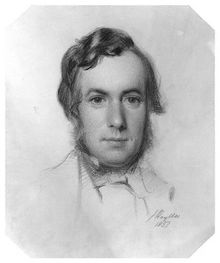
Francis Stephen Cary
Francis Stephen Cary was born in Kingsbury in Warwickshire, a younger son of the Rev. Henry Francis Cary, (author, and translator of Dante) who was the local vicar. His brother Henry became a judge in New South Wales in Australia.
Cary was educated at home, chiefly by his father, before becoming a pupil of Henry Sass at the latter’s well-known art academy in Bloomsbury, London. He later became a student at the Royal Academy and for a short time painted in the studio of Sir Thomas Lawrence. Lawrence died before he could have become a pupil.
In 1829, Cary studied in Paris and afterwards in Italy and in the Art School at Munich. In 1833, 1834 and 1836, he accompanied his father on a foreign tour. In the following years he exhibited several pictures at the Society of British Artists and other venues.
In 1841, he married Louisa, daughter of Charles Allen Philipps of St. Bride’s Hill, Pembrokeshire. The following year he took over the management of Sass’s Art School in Bloomsbury, founded by Henry Sass on the model of the Italian Bolognese School of painting. – the school at which he had previously studied. Cary continued to exhibit pictures for some years at the Royal Academy and elsewhere, and was a candidate in the Westminster Hall competitions for the decoration of the Houses of Parliament, held in 1844 and 1847.
At the Bloomsbury Art School many of the prominent painters and sculptors of the day, such as Charles West Cope, John Everett Millais, Dante Gabriel Rossetti, Henry Hugh Armstead, James Hayllar etc., received their early art education, as did several female artists such as Anna Mary Howitt and Jane Benham Hay, at a time when other such opportunities were still closed to them.
In 1874, Cary retired to Abinger in Surrey, where he died on 6 January 1880. He left no family. In the early part of his life, through his father’s social connections, he enjoyed much of the literary society of that day. He painted an interesting portrait of Charles and Mary Lamb, commissioned by John Mathew Gutch.


Conclusion of the Trolling Series-We’ll All Go A Trolling
We’ll All Go A Trolling Not only do I write Regency and Romance, but I also have delved into Fantasy.
The Trolling series is the story of a man, Humphrey. We meet him as he has left youth and become a man with a man’s responsibilities.
We follow him in a series of stories that encompass the stages of life. We see him when he starts his family, when he has older sons and the father son dynamic is tested.
We see him when his children begin to marry and have children, and at the end of his life when those he has loved, and those who were his friends proceed him over the threshold into death.
All this while he serves a kingdom troubled by monsters. Troubles that he and his friends will learn to deal with and rectify. It is now available in a variety of formats.
For $2.99 you can get this fantasy adventure.
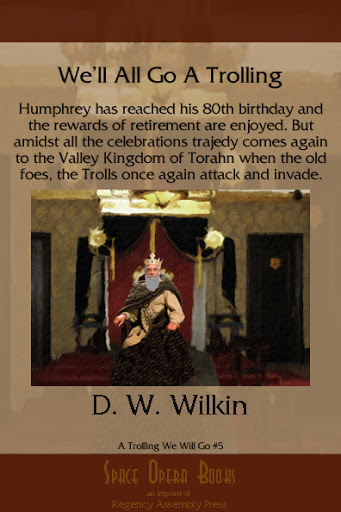
Barnes and Noble for your Nook
King Humphrey, retired, has his 80th birthday approaching. An event that he is not looking forward to.
A milestone, of course, but he has found traveling to Torc, the capital of the Valley Kingdom of Torahn, a trial. He enjoys his life in the country, far enough from the center of power where his son Daniel now is King and rules.
Peaceful days sitting on the porch. Reading, writing, passing the time with his guardsmen, his wife, and the visits of his grandson who has moved into a manor very near.
Why go to Torc where he was to be honored, but would certainly have a fight with his son, the current king. The two were just never going to see eye to eye, and Humphrey, at the age of 80, was no longer so concerned with all that happened to others.
He was waiting for his audience with the Gods where all his friends had preceded him. It would be his time soon enough.
Yet, the kingdom wanted him to attend the celebrations, and there were to be many. So many feasts and fireworks he could not keep track, but the most important came at the end, when word was brought that the Trolls were attacking once more.
Now Humphrey would sit as regent for his son, who went off to fight the ancient enemy. Humphrey had ruled the kingdom before, so it should not have been overwhelming, but at eighty, even the little things could prove troublesome.
Feedback
If you have any commentary, thoughts, ideas about the book (especially if you buy it, read it and like it
August 1, 2016
Regency Personalities Series-General Charles Murray Cathcart 2nd Earl Cathcart
Regency Personalities Series
In my attempts to provide us with the details of the Regency, today I continue with one of the many period notables.
General Charles Murray Cathcart 2nd Earl Cathcart
21 December 1783 – 16 July 1859
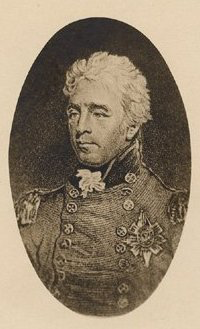
Charles Murray Cathcart
General Charles Murray Cathcart 2nd Earl Cathcart was born at Walton, Essex, on 21 December 1783, the eldest surviving son of William Cathcart, 10th Lord Cathcart (later the 1st Earl Cathcart)
Cathcart entered the army as a cornet in the 2nd Regiment of Life Guards on 2 March 1800. He served on the staff of Sir James Craig in Naples and Sicily. He became heir apparent to the lordship of Cathcart in 1804, after his brother William Cathcart, Master of Cathcart died while commanding a Royal Navy vessel in the West Indies. After his father was elevated to an earldom in 1814 he became known by the courtesy title Lord Greenock.
Cathcart saw service on the ill-fated Walcheren Expedition in 1809 and at the siege of Flushing, after which for some time he was disabled by the injurious effects of the pestilence which cut off so many thousands of his companions. Becoming lieutenant colonel on 30 August 1810, he embarked for the Peninsula, where he was present at the Battle of Barrosa, for which he received a gold medal on 6 April 1812, at the Battle of Salamanca, and the Battle of Vitoria, during which he served as assistant quartermaster-general.
He was next sent to assist Sir Thomas Graham in Holland as the head of the quartermaster-general’s staff, and was afterwards present at the Battle of Waterloo, where he had three horses shot from under him. He was awarded the Russian Order of St. Vladimir, the Dutch Military William Order, and made a Companion of the Order of the Bath (CB). In 1823, he was appointed a lieutenant colonel in the royal staff corps at Hythe.
In 1830 he moved to Edinburgh where lived at “Whitehouse villa” on Bruntsfield Links. He became involved in the proceedings of the Highland Society, became a Fellow of the Royal Society of Edinburgh and where he announced the discovery of a new mineral, a sulphide of cadmium, which was found in excavating the Bishopton tunnel near Port Glasgow and which is now known as Greenockite. On 17 February 1837 he was made Commander-in-Chief, Scotland and Governor of Edinburgh Castle. On 17 June 1838, on the death of his father, he became second earl and eleventh baron Cathcart. On 16 March 1846 he was appointed commander-in-chief in British North America from 16 March 1846 and in 1850 he was appointed to the command of the Northern and Midland District, and in 1855 he retired.
On 30 September 1818 he married Henrietta Mather, daughter of Thomas Mather in France. The couple remarried at Portsea, England, 12 February 1819. Lady Cathcart accompanied her husband, and their daughters, to Canada in June, 1845. Lady Cathcart presented colours to one of the militia regiments in Montreal. The family returned to England in May, 1847. She died on 24 June 1872. He died at St. Leonard’s-on-Sea on 16 July 1859.
He was the author of two papers in the Transactions of the Royal Society of Edinburgh in 1836, On the Phenomena in the neighbourhood of Edinburgh of the Igneous Rocks in their relation to the Secondary Strata, and The Coal Formation of the Scottish Lowlands.


RAP has The End of the World
The End of the World This is the first of the Regency Romances I published. It is available for sale and I hope that you will take the opportunity to order your copy.
For yourself or as a gift. It is now available in a variety of formats. And now at the reduced price of $3.99 you can get this Regency Romance for your eReader. A little more as an actual physical book.
Barnes and Noble for your Nook
Amazon for your Kindle and as a Trade Paperback
Hermione Merwyn leads a pleasant, quiet life with her father, in the farthest corner of England. All is as it should be, though change is sure to come. For she and her sister have reached the age of marriage, but that can be no great adventure when life at home has already been so bountiful.
When Samuel Lynchhammer arrives in Cornwall, having journeyed the width of the country, he is down to his last few quid and needs to find work for his keep. Spurned by the most successful mine owner in the county, Gavin Tadcaster, Samuel finds work for Gavin’s adversary, Sir Lawrence Merwyn.
Can working for Sir Lawrence, the father of two young women on the cusp of their first season to far away London, be what Samuel needs to help him resolve the reasons for his running away from his obligations in the east of the country?
Will the daughters be able to find happiness in the desolate landscapes and deadly mines of their home? When a stranger arrives in Cornwall while the war rages on the Peninsula, is he the answer to one’s prayers, or a nightmare wearing the disguise of a gentleman?
Feedback
If you have any commentary, thoughts, ideas about the book (especially if you buy it, read it and like it
July 31, 2016
Regency Personalities Series-William Andrews Nesfield
Regency Personalities Series
In my attempts to provide us with the details of the Regency, today I continue with one of the many period notables.
William Andrews Nesfield
1793–1881
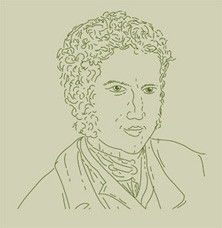
William Andrews Nesfield
William Andrews Nesfield was born at Lumley Park, County Durham. In 1808, after the death of his mother, the family moved the few miles to Brancepeth where his father became rector of St Brandon’s church. His stepmother was Marianne Mills of Willington Hall, whose nephew was the noted architect Anthony Salvin, and Nesfield’s younger sister married Salvin.
Nesfield was educated at Durham School, then located on Palace Green, before entering the army. He fought under Wellington in Spain and at Waterloo, and he also served for two years in Canada, where he was present at the Siege of Fort Erie and the Battle of Chippawa. He retired in 1816, and took up a career as a painter of watercolours, particularly of waterfalls, earning the praise of John Ruskin in Modern Painters.
While still exhibiting at the Old Water Colour Society, Nesfield began work as a professional landscape architect, with the encouragement of Salvin.
From 1840 until his death in 1881 he was responsible, either singly or with his sons Arthur Markham and William Eden for no fewer than 259 commissions in the British Isles. His military training enabled him to design the water features which were so effective in many of his gardens.
The Witley Court fountain in Worcestershire, which cost the equivalent of more than £1 million in 1853, is the triumphant centrepiece of elegant gardens designed by Nesfield, who described them as his “monster work”. It has 120 separate jets hidden amongst giant shells, sea nymphs, dolphins and a monstrous serpent. The main jet reaches up to 90 feet (27 m). Performing artist Bing Crosby was keen to acquire the fountain for his Hollywood home, but the monumental, 20-ton, block sculpture with 54-metre-wide pool, which can be compared to the smaller Trevi Fountain in Rome and fountains at Versailles, remained in England. The gardens and fountain were designed to reflect the wealth of the 1st Earl of Dudley and the grandeur of his Italianate mansion, which was often visited by royalty and other rich landowners. Nesfield’s dramatic south parterre was set against the wide spaces of the surrounding parkland and the distant wooded wild landscape.
Castle Howard’s South Lake in North Yorkshire was refashioned by Nesfield at the same time as he installed the Prince of Wales Fountain in the 1850s. Ten years later between the South Lake and New River Bridge, the area was formalised with the construction of the Cascade, Temple Hole Basin and the Waterfall. These features remained but fell into disrepair after the 9th Countess changed Nesfield’s planting which surrounded the South Lake.
Oxon Hoath in Kent was built more than 600 years ago by Sir John Culpeper, a knight of King Henry V, as a royal park for oxen and deer. Over the centuries the estate has been the family home to eleven knights, many of whom enhanced the house and grounds in a variety of classical architectural styles. In 1846 Sir William Geary commissioned the renowned French gothic revivalist architect Anthony Salvin to build the mansard dome, and the chateau tower. Sir William, son of Admiral Sir Francis Geary who was Nelson’s mentor, also engaged W. A. Nesfield to create the formal gardens in the style of Capability Brown. The Oxon Hoath gardens are the only surviving unaltered parterre gardens in England today.
Three great vistas are Nesfield’s signature on today’s Kew Gardens, London. In a ‘goose foot’ pattern radiating from the Palm House, Pagoda Vista was a grassed walk some 850 m (2,800 ft) long; Syon Vista was a wide gravel-laid walk stretching 1,200 m (3,937 ft) towards the Thames; while the third, short, vista fanned from the northwest corner of the Palm House and focused on a single 18th-century cedar of Lebanon towards Kew Palace. Pagoda Vista is lined with paired broadleaved trees with, flanking them and to their exterior, paired plantings of evergreens. Nesfield’s idea of being able to both see and walk to the Pagoda along the centre line of Kew Gardens was, in fact, a return to the turn-of-the-century landscape.
Treberfydd house was built near Brecon by John Loughborough Pearson for the Raikes family in 1852. The Treberfydd grounds contain the only remaining example of a Nesfield garden still tended by descendents of the patron for whom he created it. While the detailed planting of the Nesfield parterre has been grassed over, Treberfydd contains one of the gardener’s signature vistas, called The Long Walk. It can be found by standing at the gate of the kitchen gardens and looking back through a landscaped woodland to the manicured lawns of the estate.
Kinmel Hall is the third house to be built on the site in Conwy county borough. Designed by W. A. Nesfield’s son, William Eden Nesfield, it was completed in the 1870s, and W. A. Nesfield was responsible for the adjoining 18 acres (73,000 m2) of walled gardens.


RAP (Regency Assembly Press) in need of Beta-Readers
Regency Assembly
Press
is looking for
Beta Readers
One novel is ready for Beta Reading
We have a continuation of Pride and Prejudice with Ms Caroline Bingley and her fortune at stake:
Do we think that Mr Hurst married his Bingley Bride without incentive? It is highly probable that Caroline Bingley, even though she has a sharp, acerbic tongue, still is in possession of a fortune and an astute fortune hunter who deciphers this may soon be on the road to, if not a happy marriage, one with financial security.
Please respond or send an email if you are interested



